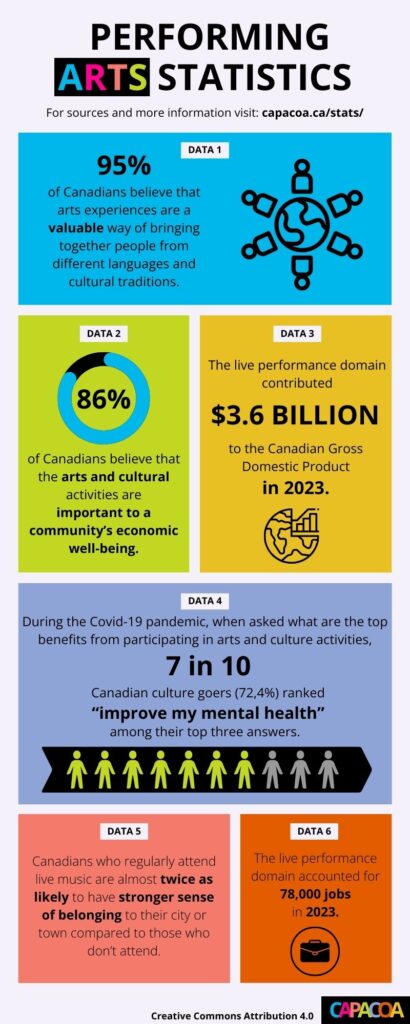
This page lists selected research findings and statistics about the Canadian performing arts sector, also referred to as the live performance domain. Research findings are usually cited verbatim. Statistics are processed and synthesized by CAPACOA.
Live Presentation in Canada
Presenting Networks
Public Funding of Arts Presentation
Attendance and Importance of the Performing Arts
Economic Impact of the Performing Arts
Public Benefits and Social Impacts of the Performing Arts
Arts, Identity, and Belonging
Public Benefits of Performing Arts Facilities
Performing Arts and Health
Public Support to the Arts
Other Sources of Arts Statistics
Live Presentation in Canada
- The live performance domain “includes live performances of theatre, dance, opera, musical theatre, orchestras, music groups and artists, circuses, puppetry, and multidisciplinary events such as celebrations and festivals. The domain includes promoters and presenters involved with live performances, as well as the physical infrastructure used to house these events where these are facilities dedicated to live performance such as theatres or concert halls.”
Source: Statistics Canada, Conceptual Framework for Cultural Statistics 2011, p. 41.
- The live performance domain was comprised of 11,503 organizations and businesses in 2022 in Canada.
- Of these, 8,617 were performing arts companies and 2,886 were presenters/promoters and festivals. 2,174 had employees; 9,329 did not have employees.
Source: Statistics Canada, Tables 33-10-0568-01, 33-10-0569-01, 33-10-00661-01, 33-10-00662-01, Canadian Business Counts, with and without employees, June and December 2022. Calculations by CAPACOA. NAICS industry categories included in these calculations are consistent with the mapping for the live performance domain in the Classification Guide for the Canadian Framework for Culture Statistics 2011.
- Presenting organizations in Canada, including series presenters and festivals, presented more than 80,000 performances by professional artists, and paid artistic fees estimated at more than $200 million in 2011.
Source: CAPACOA, Interim Report of Findings, The Value of Presenting, 2012.
Presenting Networks
There are 39 presenting networks in Canada. Presenting networks are national in scope or regionally-based and typically serve non-profit presenters as well as municipal presenters, festivals and university presenters. Other presenting networks are specialized in one type of presenting activity and may serve festivals or presenters specialized in disciplines, such as dance or theatre.
Breakdown of presenting networks in Canada:
- 26 regional multidisciplinary networks (6 of which also serve schools);
- 5 festival networks, 3 of which also have an additional focus (jazz music, children programming, theatre);
- 8 specialized networks.
Sources: Survey led by CAPACOA in April 2010 and list of presenting support organizations funded by Canadian Heritage in 2009-2010.
Public Funding of Arts Presentation
One of the main source of funding for live presentation at the federal level is the Canada Arts Presentation Fund. In 2021-2022, the CAPF provided $39.8 million in grants and contributions to 781 professional arts festivals and performing arts series in more than 270 cities or communities across Canada.1 From 2013-14 to 2017-18, the program supported on average 38,210 performances per year and the average number of attendees was 22.4 million per year.2 For every dollar invested by the program, an average of $8.50 is directly spent in the Canadian economy.4
Sources:
1 Canada, information provided by CAPF program managers in October 2022 and April 2023.
Note: This total includes the supplemental funding first announced in the 2019 budget and extended in the 2021 budget. It however does not include the Support for Workers in Live Arts and Music Sectors Fund, nor the Recovery Fund for Arts, Culture, Heritage and Sport Sectors.
2 Canada, Grouped Arts Evaluation: Canada Arts Presentation Fund, Canada Cultural Spaces Fund, and Canada Cultural Investment Fund 2013-14 to 2017-18, 2019.
3 Canada, Grouped Arts Evaluation: Canada Arts Presentation Fund (CAPF), Canada Cultural Spaces Fund (CCSF), Canada Cultural Investment Fund (CCIF), 2014.
Attendance and Importance of the Performing Arts
- Seven in ten Canadian (68%) a performing arts event or an artistic or cultural festival in 2016. This attendance rate is high across all demographic groups.
Source: Statistics Canada, 2016 General Social Survey, as analyzed in Hill Strategies Research, Canadians’ Arts, Culture, and Heritage Participation in 2016, 2018.
- Seven in ten (69%) Canadians consider arts and cultural events to be either very (27%) or moderately important (42%) to their own and their family’s quality of life.
Source: Environics Research, Arts and Heritage Access and Availability Survey 2016-2017.
- Three in four Canadians (75%) attended a performing arts performance by professional artists in 2011.
- 79% of Canadians say they would miss it if there were no live, professional performing arts available in their community (21% to a moderate extent and 58% to a high extent).
Source: EKOS Research Associates, Survey of the General Public, The Value of Presenting, 2012.
Economic Impact of the Performing Arts
- The live performance domain contributed $3.6 billion to the Canadian Gross Domestic Product in 2023. In constant dollars, this is essentially the same as in 2019 (-0.1%).
- The live performance domain accounted for 78,000 jobs in 2023. This is 3.3% more than in 2019.
Source: Statistics Canada, Table 36-10-0652-01 National culture and sport indicators by domain and sub-domain. Release date: 2024-04-15. Calculations by CAPACOA.
- The live performance GDP grew at an annual rate of 5.9% between 2010 and 2019.
- Live performance jobs grew at an annual rate of 3.9% between 2010 and 2019.
Source: Statistics Canada, Table 36-10-0452-01 Culture and sport indicators by domain and sub-domain, by province and territory, product perspective. Release date: 2023-06-26. Calculations by CAPACOA.
- In 2019, revenues from admissions to live performing arts performances in Canada totaled $3.8 billion. This represented GST/HST revenues of $190 million for the federal government alone.
Source: Statistics Canada, Table 36-10-0478-01 Supply and use tables, detail level, provincial and territorial (x 1,000). Calculations by CAPACOA.
- International visitors spent $220 million in direct spending for live performance events in Canada in 2016 ($188 million for performing arts events and $32 million for festivals and celebrations). This represents 1.1% of total tourism spending and 6.4% of non-tourism commodities (expenses other than travel, accommodation and food). This is more than for any other culture and sports sub-domains, including organized sports ($171 million).
Source: Statistics Canada, National Tourism Indicators survey no. 1910 and Culture Satellite Account.
Note: Many festivals and other live events attended by tourists are free events. Although these events do not generate direct spending, they generate significant spin-off spending.
- The average Ontario arts and culture tourist spends twice as much per trip as does a typical tourist – $667 per trip versus $374.
Source: Research Resolutions & Consulting, Ontario Arts and Culture Tourism Profile, 2013.
- 65% of businesses and skilled workers agree that a thriving arts and culture scene is a driving factor when considering relocation.
Source: Nanos Research, Culture for Competitiveness: How Vibrant Culture Attracts Top Talent, 2016.
- Arts and culture activities were featured in one eighth (13%) of all tourist trips which contributed to 30% of tourism spending in the province.
- Arts and culture tourists spend more: “the average arts and culture visit represents $618 in economic impact compared to $213 for an average non-arts and culture visit.”
- 30% of international visits include attending performances (concerts and plays) and visiting museums and art galleries as top attractions.
Source: Forum Research, Ontario Arts and Culture Tourism Profile, 2023.
Public Benefits and Social Impacts of the Performing Arts
- Nine in ten Canadians believe they get personal benefits out of attending professional performing arts. Most perceive the main benefit to be the entertainment experience of it (84%), but other benefits are recognized, such as emotional, spiritual or intellectual stimulation, an opportunity to experience something new, providing exposure to different cultures, and providing an opportunity to socialize.
- 2 in 3 Canadians (65%) believe that the community as whole benefits more or as much as individual attendees from the presentation of the performing arts.
- Canadians believe that the presentation of performing arts brings energy and vitality to communities, improves quality of life and well-being of residents, makes communities more creative and fosters a stronger sense of pride and identity.
Source: EKOS Research Associates, Survey of the General Public, The Value of Presenting, 2012.
- 95% of Canadians believe that arts experiences are a valuable way of bringing together people from different languages and cultural traditions.
- 95% of Canadians believe that arts are an important way of helping people think and work creatively.
- 94% of Canadians believe that arts and culture make a community a better place to live.
- 92% of Canadians believe that exposure to arts and culture is important to individual well-being.
- 89% of Canadians believe that the arts and culture help us express and define what it means to be Canadian.
- 86% of Canadians believe that the arts and cultural activities are important to a community’s economic well-being.
Source: Environics Research, Arts and Heritage Access and Availability Survey 2016-2017.
- Over nine in ten residents of Ontario strongly agree or somewhat agree that arts activities help enrich the quality of our lives.
Source: Nanos Research, Impressions of the Impact of the Arts on Quality of Life and Well-Being in Ontario, 2017.
- Festival attendees are twice as likely as non-attendees to volunteer, even accounting for other factors.
- Classical music attendees are 29% more likely to report very strong satisfaction with life than non-attendees, even accounting for other factors.
- In general, arts goers have better health, higher volunteer rates, and stronger satisfaction with life.
Source: Hill Strategies, The Arts and Individual Well-Being in Canada, 2013.
- Adults who attend live arts performances, art museums or art galleries are far more likely than non-attendees to vote [38% more, in the case of live arts attendees], volunteer, or take part in community events.
Source: National Endowment for the arts, Art-Goers in Their Communities: Patterns of Civic and Social Engagement, 2009.
- Participation in the arts, especially as audience, predicts civic engagement, tolerance and altruism.
Source: University of Illinois at Chicago, “Interest in arts predicts social responsibility,” ScienceDaily, 16 Aug. 2012.
Arts, Identity and Belonging
- Canadians who regularly attend live music are almost twice as likely to have stronger sense of belonging to their city or town compared to those who don’t attend.
- Canadians who rate arts, culture and leisure in their community as “excellent” are nearly three times more likely to report a “very strong” sense of belonging to their city or town.
Source: Community Foundations of Canada and CAPACOA, Vital Signs: Arts and Belonging, 2017.
- 79% of Canadians consider that arts and heritage experiences makes them feel part of their local comunity.
Source: Environics Research, Arts and Heritage Access and Availability Survey 2016-2017.
- Nine in ten Ontarians strongly agree or somewhat agree that arts experiences help bring people from diverse backgrounds together as a community
- Just under nine in ten Ontarians strongly agree or somewhat agree that participating in arts
activities builds a shared sense of community identity.
Source: Nanos Research, Impressions of the Impact of the Arts on Quality of Life and Well-Being in Ontario, 2017.
Public Benefits of Performing Arts Facilities
- Canadians believe that performing arts venues provide community-wide benefits, such as improved quality of life (87% say moderate to high importance), fostering a sense of community pride (87%), contributing to economic development (88%), and greater community safety through increased activity at night (60%).
Source: EKOS Research Associates, Survey of the General Public, The Value of Presenting, 2012.
- 87% of Canadians feel that live performance spaces in their community contribute to quality of life.
Source: Environics Research, Arts and Heritage Access and Availability Survey 2016-2017.
- 80% of Canadians agree theatres are important for attracting visitors to communities.
Source: Nanos Research, Canadian Theatre: Creating Vibrant Communities, 2014.
Performing Arts and Health
- People who attend theatre or comedy performances are 26% more likely to report very good or excellent health, even taking into account socio-economic factors. Live music attendees (including popular and classical music) are 23% more likely to report very good or excellent health. For arts or cultural festival attendees, it’s a 12% difference.1
- People who attend theatre or comedy performances are 19% more likely to report very good or excellent mental health than non-attendees, even taking into account socio-economic factors. Live music attendees (including popular and classical music) are 15% more likely. Moderate frequency is enough to observe this relationship.1
- During the Covid-19 pandemic, when asked what are the top benefits from participating in arts and culture activities, 7 in 10 Canadian culture goers (72,4%) ranked “improve my mental health” among their top three answers.2
- Arts activities led to participants’ healthy personal development, there was clear evidence of healthy eating, healthy mothering and more positive mental health, and health information was more readily absorbed.2
- Those who engaged in 100 or more hours/year of arts engagement (i.e. two or more hours/week) reported significantly better mental well-being than other levels of engagement.3
- People who attend theatre/dance and pop or classical concerts are more likely to report good health and quality of life, even after adjusting for other factors.4
- People who attend concert, theatre or film are significantly healthier, have lower anxiety and are less subject to depression, even when adjusting for relevant cofactors.5
- The more frequently people attend performing arts and other receptive arts, the more likely they are to report good health.5,6
- Attending concerts and theatre increases perceived vitality.7,8
- Attending cultural events is linked with longevity. People who rarely attend such events run a nearly 60% higher mortality risk than those attending most often.9
- Rare and moderate cultural events attendees in urban areas are 3 times more likely to die of cancer over time than frequent attendees.10
- More arts and health facts from Hill Strategies Research
Sources:
1 Hill Strategies, Canadians’ Arts Participation, Health, and Well-Being, based on Statistics Canada’s 2016 General Social Survey, 2021.
2 Nanos Research, Arts Response Tracking Study, February 2022 edition.
3 Geoffrey Crossick and Patrycja Kaszynska, Understanding the Value of Arts & Culture: The AHRC Cultural Value Project, 2016.
4 Christina Davies et al., The art of being mentally healthy: a study to quantify the relationship between recreational arts engagement and mental well-being in the general population, 2015.
5 Tellervo Nenonen et al., Cultural services and activities: The association with self-rated health and quality of life, 2014.
6 Koenraad Cuypers et al., Patterns of receptive and creative cultural activities and their association with perceived health, anxiety, depression and satisfaction with life among adults, 2011.
7 Anna Wilkinson et al., Are variations in rates of attending cultural activities associated with population health in the United States?, 2007.
8 Lars Olov Bygren et al., Cultural participation and health: a randomized controlled trial among medical care staff, 2009.
9 Töres Theorell et al., A note on designing evaluations of health effects of cultural activities at work, 2009.
10 Lars Olov Bygren et al., Attendance at cultural events, reading books or periodicals, and making music or singing in a choir as determinants for survival, 1996.
11 Lars Olov Bygren et al., Attending cultural events and cancer mortality: A Swedish cohort study, 2009.
Public Support to the Arts
- Volunteers are crucial in performing arts presentation: for each paid staff member working in the field, there are 17 volunteers giving their time, thereby enabling a broad range of benefits for their community.
Source: Strategic Moves, Survey of Performing Arts Presenters, The Value of Presenting, 2012.
- Canadians volunteered 107 million hours for arts and culture organizations in 2013. This is the equivalent to 56,000 full-time jobs.
- Those Canadians who volunteered gave on average more time for arts and culture than any other sector in 2013 (120 hours).
- Between 2004 and 2013, the number of volunteers in arts and culture organizations increased by 23%, much higher than the 7% increase in all volunteers.
- One million Canadians (3%) donated $162 million to arts and culture organizations in 2013.
- The total donations and the number of donors have increase at higher pace for arts and culture organization than for other not-for-profit organizations between 2007 and 2013 (respectively 46 vs. 16% and 34 vs. 6%).
Source: Statistics Canada, General Social Survey on Giving, Volunteering and Participating, 2013.
- 70% of Canadians consider that Canada still needs specific protection policies and support from government for Canadian culture to survive.
- There is a very strong relationship between attachment to Canada and assessment of its culture. Canadians who have a deep emotional attachment to Canada are more likely to believe that there is a unique Canadian culture (84% vs. 76%, n=1525). They are also more likely say that there is “something special” to it (86% vs. 74%).
Source: Angus Reid Institute, Culture, the CBC & the CRTC: both institutions get good marks, but future relevance seen as a challenge, 2015.
- Nine in ten Canadians (88%) agree with governments providing support for the arts and culture.
Source: Environics Research, Arts and Heritage Access and Availability Survey 2016-2017.
Source: Capacoa.ca











